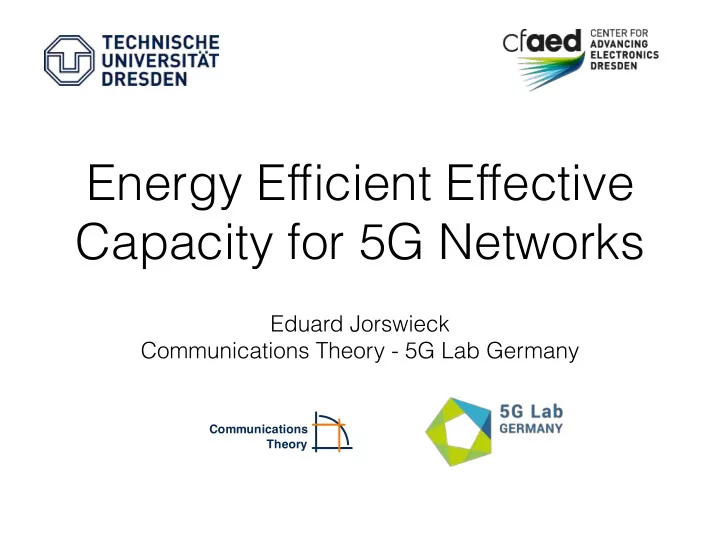

Energy Efficient Effective Capacity for 5G Networks Eduard Jorswieck Communications Theory - 5G Lab Germany Communications Theory
joint work with • Dr. Martin Mittelbach (TU Dresden) • Dr. Rami Mochaourab (KTH Access Center) • Dr. Christian Isheden (Actix Dresden) • Mahnaz Sinaie (guest PhD student, Tehran, Iran) • Prof. Emil Björnson (Linköping, SE) • Prof. Merouane Debbah (Supelec, FR) • Prof. Björn Ottersten (KTH & SnT, UoL)
Cellular Roadmap of USPs 5G – 2022 + Tactile Internet + massive M2M + Tb/s + “carrier grade” + safe & secure 4G – 2012 + Video everything 3G – 2002 + 3D Graphics + Data 2G – 1992 + Positioning Voice Messages G. Fettweis and Siavash Alamouti. “5G: Personal Mobile Internet beyond What Cellular Did to Telephony”, IEEE Communications Magazine, 52.2 (2014): 140-145.
5G - Massive Requirements <"1ms"RTT >"10Gbit/s"per"user <" 10 ↑ −8 "outage" <" 10 ↑ −12 "security" >"10k"sensors"per"cell 10x10$heterogenity$ Massive throughput Massive reduction in latency State of the art Massive sensing Massive resilience Massive safety and security Massive fractal heterogeneity
Problem Statement • Conflicting performance metrics: • Data rate / throughput • Delay / latency • Energy efficiency • Multi-Objective Programming (MOP) problem E. Björnson, E. Jorswieck, M. Debbah, B. Ottersten, "Multi-Objective Signal Processing Optimization: The Way to Balance Conflicting Metrics in 5G Systems", IEEE Signal Processing Magazine, vol. 31, no. 6, pp. 14-23, Nov. 2014.
Preliminary Results I • MISO / MIMO average effective capacity maximization with statistical channel state information at the transmitter Q ⌫ 0 , tr( Q ) P − 1 I + ρ HQH H ��⇤ ⇥ � � − θ log det max θ T log E exp E. Jorswieck, R. Mochaourab, and M. Mittelbach, “Effective Capacity Maximization in Multi-Antenna Channels with Covariance Feedback”, IEEE Trans. on Wireless Communications, vol. 9, no. 10, pp. 2988 – 2993, Oct. 2010.
Preliminary Results II • Important result for solving the programming problem: I + ρ HQH H ��⇤ ⇥� � Φ ( Q ) = − E det is concave in Q . • The optimal eigenvectors diagonalize the transmit correlation matrix. • The remaining vector (eigenvalues) programming problem can be solved efficiently .
Preliminary Results III
Efficiency of Effective Capacity • Efficiency is a measurable concept, quantitatively determined by the ratio of output to input. E ff ective Capacity Total Energy Consumed • Total energy consumed contains the contribution from the active as well as passive RF transceiver parts. G. Miao, N. Himayat, Y. Li, and A. Swami, “Cross-layer optimization for energy-efficient wireless communications: a survey,” Wireless Commun. and Mobile Computing, vol. 9, no. 4, pp. 529–542, 2009
Maximization of EEC in SISO • Programming problem: (1 + ρ p α ) − θ ⇤ ⇥ p ≥ 0 − log E max θ ( p c + p ) • Average can be computed often in closed form • Characterization of optimal solution is possible • X. Chen R. Q. Hu, G. Wu and Q. C. Li, “Tradeoff between energy efficiency and spectral efficiency in a delay constrained wireless system”, Wireless Communications and Mobile Computing, 2014. • W. Cheng, X. Zhang, H. Zhang, „Joint Spectrum and Power Efficiencies Optimization for Statistical QoS Provisionings Over SISO/MIMO Wireless Networks“, IEEE Journal Selected Areas in Communications, vol. 31, no. 5, May 2013.
Tradeoff Delay and Energy Efficiency 5 4.5 Efficient Effective Capacity [bit/s/Hz] 4 3.5 3 2.5 2 1.5 1 0.5 0 20 15 − 20 10 − 15 5 − 10 0 − 5 − 5 0 5 − 10 10 − 15 15 inverse noise variance [dB] delay parameter θ [dB] − 20 20
Extension to EEC in MIMO • Maximize Efficient Effective Capacity in MIMO with statistical CSIT: ⇥ � I + ρ HQH H �� Q ⌫ 0 , tr( Q ) P − log E exp( − θ log det max θ T (tr( Q ) + P c ) • Parametric convex program I + ρ HQH H �� ⇥ � f ( λ ) = Q ⌫ 0 , tr( Q ) P − log E max exp( − θ log det − λθ T (tr( Q ) + P c ) • Optimum at —> Dinkelbach algorithm f ( λ ∗ ) = 0 C. Isheden, Z. Chong, E. Jorswieck, G. Fettweis, "Framework for Link-Level Energy Efficiency Optimization with Informed Transmitter", IEEE Trans. on Wireless Communications, vol. 11, no. 8, pp. 2946-2957, Aug. 2012.
Impact of system parameters on the Energy / Delay tradeoff • Spatial dimensions: number of antennas, impact of spatial correlation, hardware impairments (massive MIMO), etc. • Spectral dimensions: multi-carrier (OFDM), generalized multi-carrier, correlated carriers, power delay profile • Temporal dimensions: from fast-fading (iid) to Markov models
Further (visionary) Challenges • Multi-User Systems, e.g., multi-antenna multiple access channel (MAC) is , espec- all vectors ynes rates stability called of ithout could ould gion
Global Efficient Effective Sum-Capacity • Maximize Efficient Effective Sum-Capacity ✓ ◆◆ K H k Q k H H P log E exp( − θ log det I + ρ k k =1 max Q k ⌫ 0 , tr( Q k ) P k − K P θ T ( tr( Q k ) + P c ) k =1 • Idea : Combine outer Dinkelbach algorithm with inner statistical iterative water filling • Implementation, interpretation, assessment open…
Further challenges • Discuss operational meaning of efficient effective sum capacity in the multiuser setup: • MAC versus broadcast channel (BC) (versus Interference Channel) • Distributed implementation via game theory • Standard function framework to show global stability
Thank you for your attention http://ifn.et.tu-dresden.de/tnt/
Backup Slides
Proof of Concavity
Proof of Optimality of Diagonalization
Single-stream BF
2500 Number of realizations (out of 100.000) 2000 1500 1000 500 0 0 0.5 1 1.5 2 2.5 3 3.5 4 Instantaneous rate
1 10 ergodic capacity maximization effective capacity maximization ( θ =3) instantaneous rate 0 10 − 1 10 − 2 10 0 50 100 150 200 time slot t
Recommend
More recommend